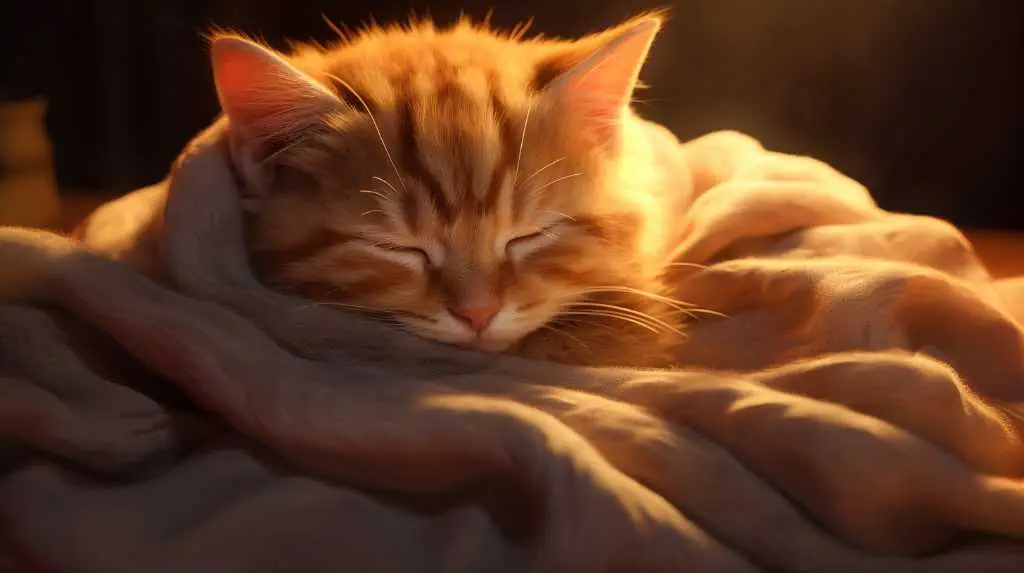The Best Fluffy Pancakes recipe you will fall in love with. Full of tips and tricks to help you make the best pancakes.

Navigating the enigmatic world of feline behaviors, you’ll find cats are like little wizards, casting spells of comfort with their paws and voices. As you strive to serve these mystical creatures better, understanding why they knead and purr becomes essential.
Kneading, often referred to as ‘making biscuits’, is a behavior rooted in kittenhood, where the motion stimulates milk flow from the mother. As adults, cats carry this comforting action into their cozy spots or even onto your lap, signaling a deep-seated sense of safety and contentment.
Purring, on the other hand, is their melodious way of expressing well-being and creating a bond with you. Mastering the subtleties of these behaviors allows you to enhance their environment and deepen the mutual trust and affection shared between you and your feline companions.
The Mystery of Kneading
You’ve likely seen a cat rhythmically pressing its paws in and out against a soft surface—a behavior known as kneading. This puzzling action can be both endearing and mystifying.
Experts suggest kneading is a comforting behavior that stems from kittenhood when they knead their mother’s belly to stimulate milk flow. As adult cats, they carry this behavior into their cozy moments, often preceding a contented nap or simply enjoying your presence.
Understanding this behavior is crucial if you’re aiming to deepen your bond with your feline friend. It’s a signal of trust and well-being. When you witness your cat kneading, it’s not just a quirky habit; it’s a moment of vulnerability and affection, an opportunity for you to nurture a safe and loving environment for them.
Purring: A Sign of Contentment
While your cat’s kneading may be a sign of relaxation, their purring is often an even clearer indicator that they’re content and comfortable in your presence. Purring serves as a communication tool and a self-soothing mechanism, reflecting a serene state of mind. Here are some scenarios where you might hear that telltale purr:
- Snuggled up on your lap during a quiet evening
- Gently rocking in the rhythm of your breathing as they sleep beside you
- Basking in the glow of a sunny windowsill, utterly at peace
- Contentedly munching on their favorite treat
- Receiving gentle strokes along their back from a caring hand
Understanding this behavior is crucial for nurturing the bond you share with your feline friend. It’s a sound that signifies you’re doing something right in their eyes.
Scratching and Territorial Claims
When your cat’s claws rake across a scratching post, they’re not just sharpening their nails—they’re marking their territory with scent glands in their paws. This behavior is both practical and instinctual.
By scratching, cats create a visual mark and spread their scent, establishing their presence and sending a clear message to other felines that this space is claimed. It’s important to empathize with their natural instincts rather than scolding them.
Providing a dedicated scratching area can help satisfy their urge to mark territory constructively. Remember, when you accommodate their needs, you’re not only preventing unwanted scratches on furniture but also supporting their emotional well-being.
Your understanding and proactive approach can create a harmonious living space for both you and your feline friend.
Instincts: From Hunting to Hiding
Often, you’ll notice your cat engaging in behaviors that stem from their primal instincts, such as pouncing on toys as if they’re prey or seeking out hidden nooks for safety. These actions aren’t just cute; they’re deeply rooted in survival strategies.
Here’s how you can better understand and support your cat’s natural behaviors:
- Stalking: Crouching and creeping towards objects, mimicking the hunt.
- Pouncing: Sudden leaps onto toys, simulating a catch.
- Climbing: Seeking higher ground for a strategic view.
- Hiding: Finding secluded spots to feel secure.
- Chattering: Vocalizing at birds or squirrels outside the window, indicating excitement or frustration.
Grooming and Communication Signals
You’ll also frequently observe your cat meticulously grooming itself, a behavior that serves both hygienic and communicative purposes. Every stroke of its tongue removes loose fur and dirt, minimizing the presence of odors that could alert predators or prey. This self-cleaning ritual is also a way your cat maintains its body temperature through saliva evaporation.
Beyond cleanliness, grooming is a nuanced language. When your cat licks you or another cat, it’s often a sign of affection or a request for social bonding. These behaviors foster connections and establish social hierarchies. By understanding these signals, you’re better equipped to support your cat’s emotional well-being.
What Does Cats Kneading and Purring Have to Do with Their Behavior around Water Bowls?
Cats’ curious cat water behavior, such as kneading and purring around their water bowls, is a common yet fascinating phenomenon. These actions are often associated with a cat’s instinctual behavior to mark territory and feel relaxed. It’s also a way for them to show contentment and comfort while drinking water.
Final Thought
As you unravel the tapestry of your cat’s behavior, remember each purr and knead weaves a story of primal instincts and affection.
Their rhythmic paws mimic ancient wild rhythms, while purrs resonate with the warmth of shared trust.
Understanding these patterns is like deciphering a feline symphony—complex, beautiful, and deeply rooted in the wilds of their heritage.
Embrace these moments; they’re the silent language of your cat’s soul, connecting your worlds with every soft press and soothing hum.








